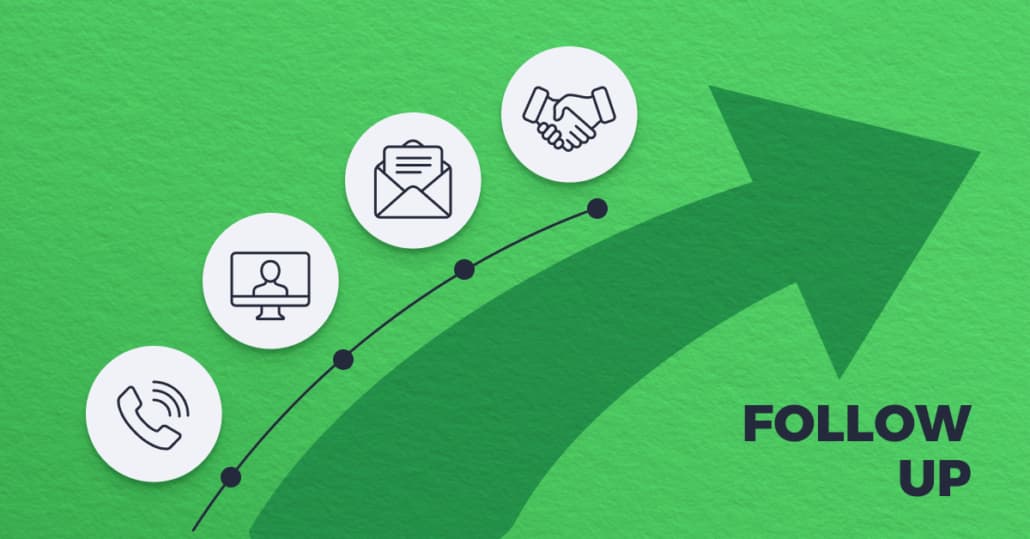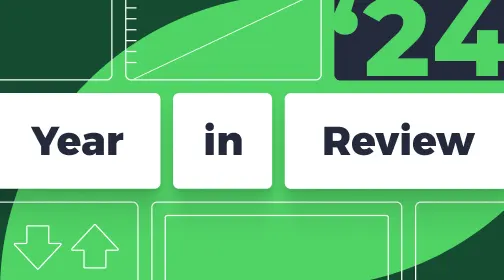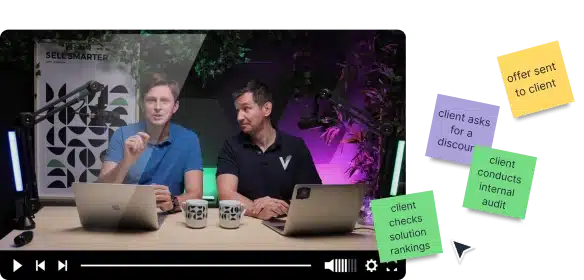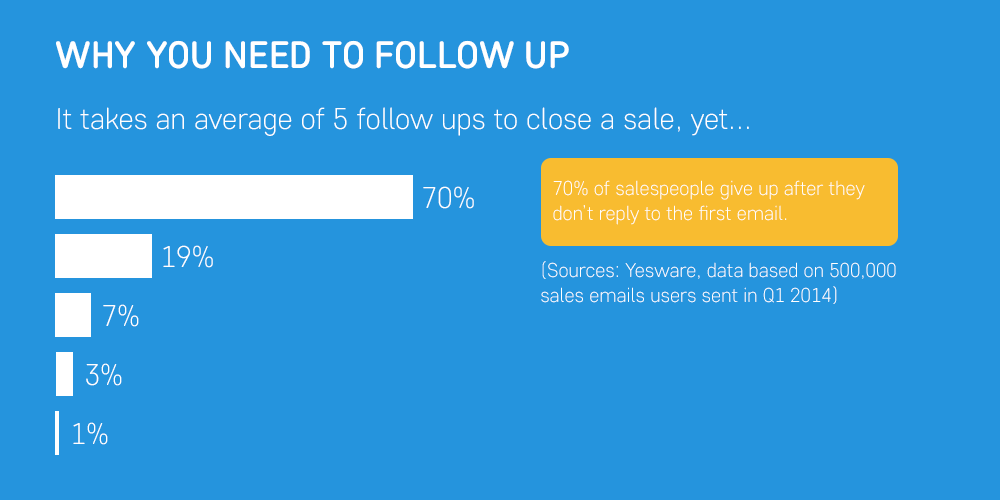Everything You Need to Know about Follow-Ups
Graham Richardson
Closing a deal can be a never-ending hustle and waiting game. First, you carry out your research in order to identify the prospects who have buying potential. Then comes the cold outreach. You launch your campaign or send your pitch, happy in the knowledge of a job well done – but it but it doesn’t end here. Your job finishes when you make a sale, and even then we should be following up and ensuring customer satisfaction. There is still a long way to go to…
It’s at this point, persistence is key because you are going to follow up with your prospects until they reply, right. In fact, persistently following up with your leads is the most underrated secret to sales success, and is a necessary skill in every profession that has to do with communication.
As a matter of fact, persistence is what drives entrepreneurs and business influencers to their greatest victories.
Okay, now you know that being persistent is key. However, it’s crucial to strike a balance in the way you email your buyers, so as to avoid bugging them or risk becoming “that guy again”.
The rule of thumb is simple → to keep the communication consistent and active, ensuring you’re following your companies approved sales strategy.
It’s worth remembering here that just because you didn’t get an instant reply – it doesn’t mean no, or that that person is not interested. It may simply mean that he or she may not be able to reply at that time. How many emails do you receive on a daily basis? Sometimes, it’s simply not feasible to reply to them all straight away.
Then, depending on the nature of that reply (or lack thereof), you can adjust your further communication accordingly and move on to the next task at hand.
There are numerous stories about persistence. Experience shows that people do eventually reply, and examples show that in some cases it can even take a full year for them to do so – so don’t be discouraged when initially it may look like you’re not getting anywhere.
Following-up is said to be more art than science, so it stands to reason that the more follow-ups you send, the better at following-up you become. Over time, you polish your message and optimize the time it takes to meet your business goals.
How many follow up emails should we send & how often?
The most frequently asked question about follow-up emails becomes: What’s the right follow-up frequency?
In other words, how often you should follow up with your prospects for the optimal results. A typical follow-up scenario should look like this:
1. Initial sales pitch
After a meeting with a customer, send an opening email immediately.
2. Subtle reminder
When there’s no response, send a subtle reminder 2 or 3 days later.
Your initial pitch might have been overlooked. People are busy or temporarily out of the office, and you may have just had some bad luck.
A clever reminder can deal with this and land you the meeting you’re after. But don’t repeat yourself! Adjust the structure of your follow up email. Ask if they saw your previous message and if they have had a chance to consider it.
3. Value bringers
Your next 3 follow-ups are technically called value bringers. Why?
Because within those emails you’re trying to pull on the right strings and evoke a reaction.
Your knowledge about your prospects pain points play a major role at this point, and each message will focus on bringing a solution.
This solution can be:
-
- A case study
-
- A success story
-
- A testimonial
-
- A referral
- A piece of relevant content – ebooks/guides that educate prospects on the relevant subject.
Simply put, you are trying to prove that:
-
- your product solves the basic pain points of your buyers.
-
- that you are credible and well-known companies have had successful experiences with your solutions.
- that you can add something of value to your prospect business.
These follow-ups should have a break of 3-4 days between them, until you get your answer.
4. Break-up email
Your last follow-up message, called a break-up email, should be sent 4-5 days after your previous message.
At this stage, you’ve sent your sequence of emails and follow-ups and provided relevant content, but to no avail. Before you run the risk of entering spamming territory, try adjusting your strategy. Perhaps ask if they see the value in your product or service? Ask if they would like to re-connect again in say, 6 months? And if so, be sure to schedule the follow up in your calendar.
This has proven to be the best, balanced frequency for your follow-ups. Not too dense and too sparse either.
However, these are not strict rules, just guidelines to keep in mind when designing your own sequence.
For instance, when dealing with say a CEO of a global enterprise, you should give more time between emails. Instead of sending your first follow up right after the original pitch, stretch out the timing of your sequence, doubling the amount of time between each follow-up message. If your product or service is something they are interested in, respecting your prospects time is not likely to go unnoticed.
No two prospects are equal, therefore you should have your contacts segmented in detail with messages personalized before you launch any email sequence.
Pro-tip: A good practice is to use a CRM system to set up your follow-up sequence and automate the process, including the proper timing. Have everything in one place, so you won’t miss out on any messages. Your mailbox can be easily synced with the CRM software, so anytime your prospects reply, the sequence for that contact will stop and you can adjust it accordingly.
Should we really follow up with leads endlessly?
The short answer is, No. However, there are some instances where this may vary.
As a rule;
If you have established a relationship with a prospect in the past, let’s say by meeting the person at a networking event, or at a scheduled meeting, then you may feel able to follow up more frequently. This will, of course, depend on your rapport or relationship with said prospect.
Otherwise, when you’re cold mailing people whom you have never met before, you don’t have a relationship to lean on. In this case, it’s best to stop after your email follow-up sequence and forget move on.
The general rules of follow-ups
1. Persistence
As discussed at the beginning of this article, your persistence may prove key getting through to your prospects, and sometimes this may actually be why they decide to do business with you. Because you are on top of your game, and they will appreciate it.
2. Manners Maketh Man (or Woman)
No one wants to deal with a rude salesperson.
You’re the one who wants to seal the deal. And it’s business, so take your emotions out of the equation. Even if you receive a rude or curt reply, a polite response is always the way go. Put a smile on your face and maintain a friendly, positive attitude when dealing with the customer, no matter what happens.
3. Get to Your Point – Quickly
Don’t play around with words, it’s not a poem ;). Make your follow-ups simple, meaty and concise. Be direct and express your thoughts in a clear, concise manner. The longer your emails get the harder they are to understand. And you want them to be easily digested to encourage more interactions.
4. Identify the Decision Maker
Before you start pitching, it’s imperative you do your homework. Know your prospects so well, that you grasp their pain points and know how to alleviate them. This way you will fit into the conversation, touching the relevant values that are actually important to a person. When you have the right bait, your chances of getting a response are much higher.
5. Create a Sense of Urgency
When writing a sales pitch and follow-ups, create a sense of urgency. Try attaching a deadline to your special offer, so your recipients know the opportunity won’t last forever.
No matter if it’s a discount or a small giveaway, a deadline will give recipients the extra motivation to make a faster decision in your favour (fear of missing out).
6. Timing is Everything
Oftentimes, it’s not just about the message you send. It’s all about timing.
There are hours in the day when the person you are trying to engage with is simply busy or distracted by something else. Research some studies to identify the best timing for your niche and time zone, but also do your own analysis (by testing different days and hours) and find those ‘happy hours’ yourself.
For instance, it’s much better to target mid-afternoon rather than early mornings, when your prospect isn’t setting up their day or craving caffeine.
Above all, remember that people buy when they’re ready to buy, not when you’re ready to sell, so always make sure a lead you’re reaching out to with your emails is ready to receive them.
7. Integrate Sales and Marketing
At a typical organization the primary marketing goal is to get leads, and on the other end sales’ job is to close the lead. But there is a gap between those two teams.
When you’re wanting to win more business, bridge the gap between marketing and sales. Their arenas aren’t separate, so it’s best to blend them and warm up those leads together.
Rely on marketing while creating your follow-up emails. Share your knowledge about pain points and decision makers you’ve identified and let them do their magic with copywriting and A/B testing.
Join forces and establish scheduled communication with your prospects, that brings new insights to the marketing table and that can be later used to optimize your tactics. In time, these tactics will translate to sales revenue.
Have you ever thought about what happens if you don’t follow up at all?
If you fail to follow up, you stand to lose those leads who may have been otherwise, ready to buy. You won’t learn anything new about your prospects or your process, and you’ll be left wondering “What if?”.
Following up lets people know that you are interested in working with them and that you see value in connecting further. Sending a quick note to let them know you have space on your calendar for them isn’t pushy and often times, it’s the follow-up that spurs the reply.
Once a regular follow-up routine is implemented, it can open up the potential for repeat business or longer-lasting relationships.
What about you? What follow-up techniques and tips do you follow?
Tell us your #FollowUpHacks – share your thoughts and feedback in the comments or via Twitter, Facebook or LinkedIn.
Other posts

Turning ‘No’ into ‘Yes’: How to Convince Your Customers to Buy from You?

Sell Wiser, Not Harder. 3 Key Steps to Master Sales Automation







